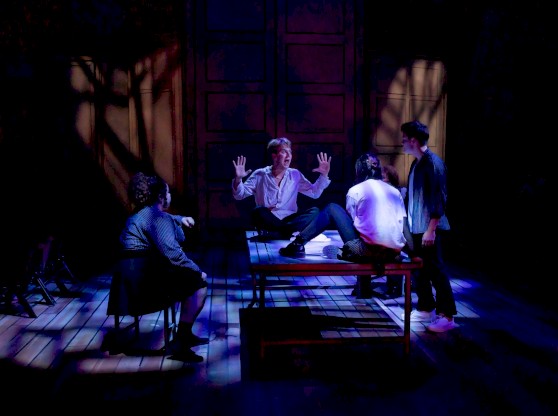The University of Florida College of the Arts has appointed Elizabeth Ross, PhD, to lead the School of Art + Art History (SAAH) as its permanent director. Her appointment began on July 1, 2022.
Since joining the College of the Arts as a faculty member in the art history program in 2005, Ross has been an accomplished and engaged participant in the university ecosystem, and a steadfast voice for the visual arts’ role in higher education, the workforce, and society.
She enters the role having held previous governance positions at the college and with a consistent history of participation in curricular and administrative updates within SAAH. Most recently, Ross served as the school’s acting director following the departure of Lynn Tomaszewski in July, 2021.
An internal search committee chaired by School of Theatre + Dance director, Peter Carpenter, PhD, conducted an intensive nationwide search for SAAH’s new director last fall.
“The work of this search committee resulted in a pool of remarkable depth and capacity. With such excellent candidates, the school is assured that its trajectory and reputation are noted among its peers—and can also rest assured that at this important juncture, the best possible candidate is going to be leading the school into its next phase,” says College of the Arts Dean, Onye Ozuzu.
The search committee cited Ross’s deep institutional knowledge of the school and university, and the insightful connections she draws between teaching, research, and leadership as deciding factors in their selection.
“Dr. Ross emerged as an undeniably strong candidate. Her submitted materials, presentation, and interviews all reinforced that she was committed to bringing out the best in SAAH faculty, staff, and students,” Carpenter says.
The committee also indicated that survey respondents from SAAH voiced support for Ross, noting that she approached the role of acting director with measured enthusiasm, honesty, and empathy during a moment of complex transition.
As SAAH director, Ross will lead administrative operations, as well as the school’s artistic, scholarly, and academic programs to: foster excellence and innovation in research and instruction in the fields of art and design, diversify and enrich curricula, cultivate intercollegiate relationships, and optimize the position of the school and college in the university-wide initiative on artificial intelligence (AI).
Within the scope of this work, the school’s director collaborates with faculty, students, and staff to reassess the school’s programs, policies, operations, and curricula to facilitate improvements in access, equity, and inclusion (AEI).
Ross says that ongoing strategic efforts at College of the Arts, combined with the university’s Faculty 500 Initiative, have resulted in an influx of diverse, new voices who join COTA’s senior and mid-level faculty and staff in shaping the college’s vision. She sees opportunity in this freshly energized space for faculty-led research, initiatives, and collaboration to guide the direction of academic programs at SAAH. Ross says:
“People seem to be receiving the message that we are committed to hiring changemakers and people who are interested in having an impact—not just in the College of the Arts, the university, and the ‘ivory tower’—but on everything else that moves beyond the traditional metrics of impact in academia. That’s been a really nice change in culture. As that happens, my role is to support the faculty. They have projects they want to pursue, research trajectories, teaching initiatives. My role is: how can we make that happen?”
Ross received the UF junior faculty International Educator of the Year award in 2011. She was named UF Teacher of the Year and received an Excellence Award for Assistant Professors from the Office of the Provost in 2012.
From 2011-2013, Ross represented her colleagues as Chair of the Faculty—an elected position in the college's system of shared governance. In this role and others, Ross demonstrates a focused, research-driven leadership style that nurtures and builds upon the input and strengths of her colleagues and students.
As program head for Art History in 2016, Ross responded to declining enrollment by employing systematic data analysis and a consensus-driven process to redesign the bachelor’s degree curriculum. Removing access barriers, paired with curricular redevelopment focused on student-led requests to decentralize traditional western narratives, resulted in a nearly two-fold increase in SAAH enrollment as of spring, 2022.
In Fall, 2020, Ross was also appointed to the Faculty Performance Advisory Committee (FPAC), where she reformed processes around the annual review for untenured faculty to be more transparent, empathetic, and in line with AEI principles that center the experiences and needs of the diverse new faculty at SAAH.
Ross was a committee member (2017-2020) in the development of UF Quest. She developed the Quest course, Revolution and Reconciliation in America and South Africa, which employs an innovative active-learning pedagogy to compare issues of race and access to power in the United States and South Africa.
“The biggest and most important ideas in American society are being contested—and that makes it an interesting place to be engaged with teaching, researching, and working with citizens of the state on cultural arts and issues. It’s a place where a lot of people feel like there’s a lot at stake with arts and culture and ideas, and that’s what makes it a more challenging environment, because everything is so politicized. But it also makes it feel like the work you’re doing—engaging with issues—is important,” Ross says.
Most recently, structural updates to the graphic design program highlight the value of visual information itself—a concept Ross says ventures beyond some traditional views of “the arts” as something arcane or inaccessible. She notes that a more expansive understanding of the role of “the visual” is central to SAAH’s mission as the school refines its programs to nurture a new generation of artists, designers, scholars, and makers.
“In K through 12 education we spend a lot of time teaching students to read and do math—verbal and numerical information—but we do not teach them to exercise the same skills around visual information,” Ross says.
“Everything around you has been created or designed by somebody who is having to grapple with the visual form of that thing—and then that thing is talking to you and shaping your experience, sometimes very profoundly. That’s what everybody in this school is committed to. In one way or another, they’re really committed to helping people understand, analyze, and shape the visual environment. When you think of the mission in that way—suddenly, it becomes a very small department for what we're doing relative to the larger university."
Ross underscores that cross-sector collaboration between SAAH’s designers, visual thinkers, and makers with other institutions across UF is vital, concluding:
“Very fundamentally, we teach our students how to make things. That is not a small thing. You must be able to conceive the need for the thing and then figure out how to put the thing together; to research materials to understand how it can be fabricated and made—and then have the skills to execute it. I feel confident that we're giving students these kinds of skills that, no matter what making looks like 20 years from now: they're going to be able to do it because they know the fundamentals and processes.”
Elizabeth Ross received her B.A. in History of Art from Yale University and her A.M. and Ph.D. in History of Art and Architecture from Harvard University. She is an associate professor of late medieval and renaissance history at University of Florida’s College of the Arts and author of Picturing Experience in the Early Printed Book: Breydenbach’s Peregrinatio from Venice to Jerusalem (Penn State University Press, 2014).



